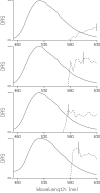The primary photophysics of the Avena sativa phototropin 1 LOV2 domain observed with time-resolved emission spectroscopy
- PMID: 21261629
- PMCID: PMC4708082
- DOI: 10.1111/j.1751-1097.2011.00903.x
The primary photophysics of the Avena sativa phototropin 1 LOV2 domain observed with time-resolved emission spectroscopy
Abstract
The phototropins are blue-light receptors that base their light-dependent action on the reversible formation of a covalent bond between a flavin mononucleotide (FMN) cofactor and a conserved cysteine in light, oxygen or voltage (LOV) domains. The primary reactions of the Avena sativa phototropin 1 LOV2 domain were investigated by means of time-resolved and low-temperature fluorescence spectroscopy. Synchroscan streak camera experiments revealed a fluorescence lifetime of 2.2 ns in LOV2. A weak long-lived component with emission intensity from 600 to 650 nm was assigned to phosphorescence from the reactive FMN triplet state. This observation allowed determination of the LOV2 triplet state energy level at physiological temperature at 16600 cm(-1). FMN dissolved in aqueous solution showed pH-dependent fluorescence lifetimes of 2.7 ns at pH 2 and 3.9-4.1 ns at pH 3-8. Here, too, a weak phosphorescence band was observed. The fluorescence quantum yield of LOV2 increased from 0.13 to 0.41 upon cooling the sample from 293 to 77 K. A pronounced phosphorescence emission around 600 nm was observed in the LOV2 domain between 77 and 120 K in the steady-state emission.
© 2011 The Authors. Photochemistry and Photobiology © 2011 The American Society of Photobiology.
Figures





References
-
- Briggs WR, Tseng TS, Cho HY, Swartz TE, Sullivan S, Bogomolni RA, Kaiserli E, Christie JM. Journal of Integrative Plant Biology. 2007;49:4–10.
-
- Kami C, Lorrain S, Hornitschek P, Fankhauser C. Plant Development. Vol. 91. Elsevier Academic Press Inc; San Diego: LIGHT-REGULATED PLANT GROWTH AND DEVELOPMENT. pp. 29–66. - PubMed
-
- Moglich A, Yang XJ, Ayers RA, Moffat K. Structure and Function of Plant Photoreceptors. Annual Review of Plant Biology, Vol 61. 2010;61:21–47. - PubMed
-
- Salomon M, Christie JM, Knieb E, Lempert U, Briggs WR. Biochemistry. 2000;39:9401–9410. - PubMed
Publication types
MeSH terms
Substances
Grants and funding
LinkOut - more resources
Full Text Sources
Other Literature Sources
Miscellaneous

